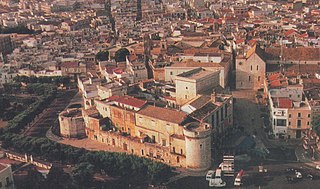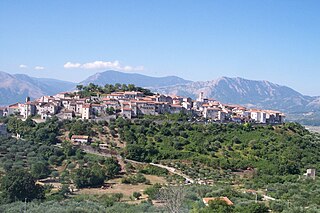
Conversano is an ancient town and comune in the Metropolitan City of Bari, Apulia, south-eastern Italy. It is 30 kilometres (19 mi) southeast of Bari and 7 kilometres (4 mi) from the Adriatic coast, at 219 metres (719 ft) above sea level.

Agropoli is a town and comune located in the Cilento area of the province of Salerno, Campania, Italy. It is situated at the start of the Cilentan Coast, on the Tyrrhenian Sea.

Sant'Angelo dei Lombardi is a town and comune in the province of Avellino in the Campania region of southern Italy. It has been a historical spot of significance in mezzogiorno history.
Salandra is a town and comune in the province of Matera, in the Southern Italian region of Basilicata.
Stigliano is a town and comune in the province of Matera, in the Basilicata region of southern Italy.

Atena Lucana is a town and comune in the province of Salerno in the Campania region of south-western Italy.

Monte San Giacomo is a town and comune in the province of Salerno in the Campania region of south-western Italy.

Sala Consilina is a town and comune in the province of Salerno in the Campania region of southwestern Italy. With 12,635 inhabitants it is the most populated town of Vallo di Diano.

San Pietro al Tanagro is a village and comune in the province of Salerno in the Campania region of south-west Italy.

San Rufo is a village and comune in the province of Salerno, in the Campania region of southern Italy located in the Vallo di Diano. San Rufo extends over 31 square kilometres, much of which is mountainous or hilly terrain. With defence in mind, the old town was built at over 600 meters above sea level. Another reason for the choice of location was the marshy nature of the wide Vallo di Diano plain, which sits at an average 450 metres above sea level.

Sant'Arsenio is a town and comune in the Province of Salerno in the Campania region of south-western Italy, located about 180 km southeast of Naples and about 76 km southeast of Salerno. As of 30 June 2006, it had a population of 2,714 and an area of 20 km2.

Sassano is a town and comune in the province of Salerno in the Campania region of south-western Italy.

Diano Castello is a comune (municipality) in the Province of Imperia in the Italian region Liguria, located about 90 kilometres (56 mi) southwest of Genoa and about 5 kilometres (3 mi) northeast of Imperia. As of 31 December 2004, it had a population of 2,061 and an area of 6.0 square kilometres (2.3 sq mi).

Padula is a comune in the province of Salerno in the Campania region of south-western Italy. It is the home of the Carthusian monastery Certosa di San Lorenzo, sometimes referred to as the Certosa di Padula. As of 2011 its population was of 5,279.

Gesù Nuovo is the name of a church and a square in Naples, Italy. It is located just outside the western boundary of the historic center of the city. To the southeast of the spire, one can see a block away the Fountain of Monteoliveto and the piazza of the church of Sant'Anna dei Lombardi. The square is a result of the expansion of the city to the west beginning in the early 16th century under the rule of Spanish viceroy Pedro Alvarez de Toledo. The square of Gesù Nuovo contains three prominent landmarks:

Policastro Bussentino is an Italian town and hamlet (frazione) of the municipality of Santa Marina in the province of Salerno, Campania region. It is a former bishopric, now titular see, and has a population of 1,625.

Cilento, Vallo di Diano and Alburni National Park is an Italian national park in the Province of Salerno, in Campania in southern Italy. It includes much of the Cilento, the Vallo di Diano and the Monti Alburni. It was founded in 1991 and was formerly known as the Parco Nazionale del Cilento e Vallo di Diano.

The Vallo di Diano is an Italian valley of the south-eastern side of Campania, in the province of Salerno.
The Cilentan dialect is a Neapolitan dialect spoken in the area of Cilento, located in the southern part of the Province of Salerno, Campania, Italy.





















